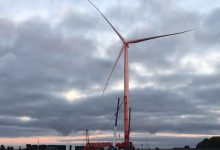Despite what federal energy minister Angus Taylor might have you believe, the announcement of the early closure of the Yallourn power station did not send the energy market into a panic. Nor should it mean the lights will go out, as many conservative commentators are claiming.
The certainty of a closure deadline and a commitment from EnergyAustralia to invest in a big battery project was largely commended, with both market participants and regulators exhibiting confidence that there will sufficient supplies of power in Victoria well into the future.
The Australian Energy Market Operator says there is about 19 gigawatts of new projects lined up as potential replacements.
“We’ve got approximately nine gigawatts of applications on our books right now,” AEMO’s head of connection in Victoria Margarida Pimental told a Clean Enegy Council webinar on Thursday, a day after the Yallourn announcement.
“And we’ve got approximately 10 gigawatts of inquiries that are starting getting that have come through, and that are eventually turning into applications.”
The closure of the 1,450MW power station will remove around one-fifth of Victoria’s electricity supply, but the industry is confident the long notice will give plenty of time for new generation to be built, along with new storage.
And as reported by RenewEconomy on Wednesday, analysis produced by the Energy Savings Industry Association suggests that household investments in energy efficiency measures could entirely offset the supply currently provided by the Yallourn power station.
AEMO forecast no future supply shortfalls out to 2029-30 under assumptions that the Yallourn power station would be progressively phased out, starting in 2029.
AEMO recently said in correspondence to the Australian Energy Regulator that it believed Australia was tracking in line with a “fast change” scenario and that new generation capacity was being added to the grid faster than initial expectations.
According to the most recent edition of AEMO’s Electricity Statement of Opportunities (ESOO), electricity demand in Victoria is expected to fall through to 2025-26, as households and businesses continue to invest in energy efficiency measures.
But Victoria’s electricity supplies are also set to be bolstered by significant investment in new wind, solar and storage projects. According to Victorian energy minister Lily D’Ambrosio, an additional 5,000MW of new renewable energy generation capacity will be added to the Victorian grid by the time that Yallourn retires.
“Since we were elected 35 projects, with more than 2500 megawatts of new renewable energy, are delivering clean energy to Victorians. We have a further 12 projects under construction that will deliver 1700 megawatts of energy. And by 2028 an additional 5000 megawatts of new renewable energy will come online,” D’Ambrosio said in a statement.
“This massive transformation is supported by more than $1.6 billion invested in clean energy in the 2020-21 Budget, including $540 million to build a modern and more resilient grid.”
Analysis undertaken by Reputex, and commissioned by Environment Victoria, found that Yallourn could feasibly close as early as 2023, with sufficient new wind and solar capacity being built in time to fill any supply gap.
Under a scenario where additional measures are undertaken to maintain stable supplies, Reputex suggested that investment in a combination of large and small scale renewable energy, adding 2.9GW of new capacity, 600MW of big battery storage, small ‘virtual power plants’ storage with a total capacity of 500MW would be enough to fill any supply gap by summer 2023.
Rystad Energy says the output of already committed wind and solar projects, plus the increase in rooftop PV, should be enough to replace nearly all the output from Yallourn.
“So existing utility scale + rooftop PV would probably be enough from an energy perspective, but obviously some firming would be needed e.g. OCGT (peaking gas), batteries, pumped hydro, demand management or additional transmission, or a combination of these,” says analyst David Dixon.
A massive pipeline of 4,657MW of solar projects have already secured planning approval but are not yet up and running.
This includes Blue Sky’s 510MW Tragowel solar farm that the company plans to build south of Kerang and the 300MW Gannawarra Stage 2 expansion being developed by Edify Energy and Wirsol.
Neoen is proposing to build 250MW solar farms at Goorambat Stewarton, with Pacific Hydro planning its own 235MW Prairie solar farm near Mitiamo and RES adding up to 235MW of solar power to the Murra Warra project.
According to the Victorian department of planning, there are an additional 1,950MW of wind projects under construction in the state, including the complete but not commissioned 530MW Stockyard Hill wind farm, the 209 Murra Warra stage 2 wind farm, the 336MW Dundonnell wind farm, which has largely been completed but is awaiting full commissioning.
There are around 1,300MW of wind projects that have already received planning clearance, including the massive 800MW Golden Plains wind farm that recently cleared legal hurdles and the 218MW Ryan Corner wind farm that has secured a construction partner.
There are three additional wind farms currently undergoing planning assessments, including the 400MW Mount Fyans wind farm, the 300MW Wimmera Plains wind farm and 76MW Inverleigh wind farm.
These projects are all additional to large-scale energy storage that will be built in the state, including a 350MW/1400MWh big battery that EnergyAustralia committed to having up and running in the Latrobe Valley by 2026 is a partial replacement for the Yallourn power station and a 300MW/450MWh big battery to be built by Neoen and Tesla which recently won financial backing from the Victorian government. AGL Energy will also add a 200MW/800MWh big battery at the site of the Loy Yang power station.
Despite Taylor warning that Yallourn’s closure may lead electricity prices to “skyrocket”, the industry and regulators seem ready to get on with the job of replacing the old brown coal plant with new clean energy technologies.








